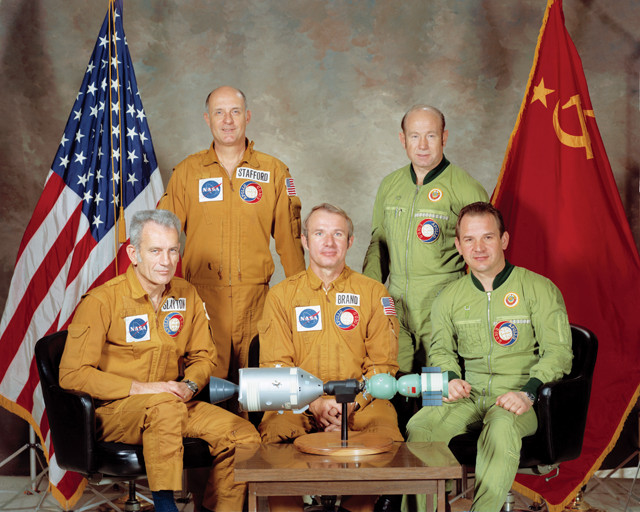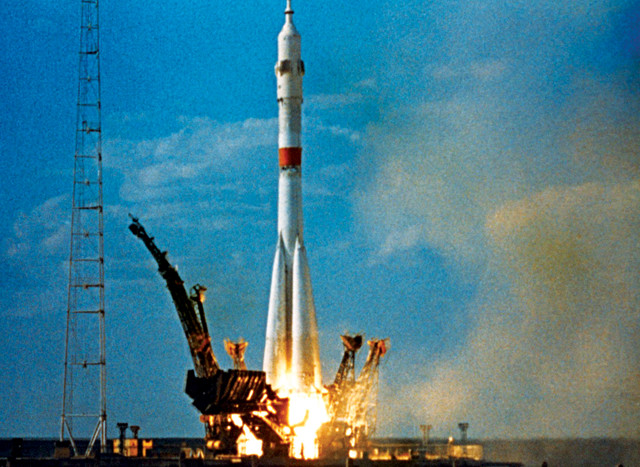
by Rachel Crowell Thursday, June 22, 2017

The crew of the Apollo-Soyuz Test Project included Apollo commander Thomas P. Stafford (standing, left), docking module pilot Donald K. "Deke" Slayton (seated, left) and command module pilot Vance D. Brand (seated, center), and Soyuz commander Alexei A. Leonov (standing, right) and flight engineer Valeriy N. Kubasov (seated, right). Credit: NASA.
The space race between the United States and the Soviet Union spurred innovations and historic firsts for humankind from Sputnik to the moon landing. However, much of the drive to break through those technological barriers and explore the vast, starry landscape of space was rooted in a desire to display military dominance in space amid the competition and animosity of the Cold War.
Nevertheless, in July 1975, the U.S. and USSR exhibited a rare moment of international collaboration and launched their first joint mission — the Apollo-Soyuz Test Project.
The nine-day mission, which saw the docking of two spacecraft and included a famous handshake in space between U.S. astronaut Thomas P. Stafford and Soviet cosmonaut Alexei A. Leonov, was the culmination of years of talks, agreements and planning between the Soviet Academy of Science and NASA.

The Soyuz spacecraft lifts off from the Baikonur Cosmodrome in Kazakhstan on July 15, 1975, in an image taken by the USSR Academy of Sciences. Credit: NASA.
Beginning in 1957, President Dwight D. Eisenhower wrote letters to persuade Soviet Premier Nikolai Bulganin, later replaced by Nikita Khrushchev, to work with the U.S. on “creating a process to secure space for peaceful uses,” according to a 2008 essay co-written by Russian space scientist Roald Sagdeev and Susan Eisenhower, President Eisenhower’s granddaughter, who were married from 1990 to 2008.
Both the U.S. and the USSR were members of the United Nations Committee on the Peaceful Uses of Outer Space, which was established in 1959. However, an important distinction existed between the U.S. and Soviet space programs. The U.S. program was divided into two separate efforts: a civilian space program devoted to advancing space science itself, and a military space program, which fell under the purview of the Pentagon and the intelligence community. The Soviet Union had developed a single, military-scientific space program.
President Eisenhower’s early efforts toward international collaboration, followed by those of President John F. Kennedy, were rebuffed by Soviet officials, Sagdeev and Eisenhower wrote. It wasn’t until 1962, when John Glenn became the first American to orbit Earth, that Premier Khrushchev sent a letter to President Kennedy echoing a desire for U.S.-Soviet space collaboration. And on May 24, 1972, U.S. President Richard Nixon and Soviet Premier Alexei Kosygin signed a groundbreaking agreement that culminated in the Apollo-Soyuz flight.
By that time, the Soviet Union and the U.S. had each made numerous breakthroughs in space. Soviet achievements ranged from launching Earth’s first successful artificial satellite to putting the first woman, Valentina Nikolayeva Tereshkova, in space. American achievements included transmitting the first pictures of Mars from space to sending the first humans, Neil Armstrong and Buzz Aldrin, to walk on the moon.
The Apollo-Soyuz crew included Soviet cosmonauts Alexei A. Leonov and Valeriy N. Kubasov, and American astronauts Thomas P. Stafford, Vance D. Brand and Donald K. “Deke” Slayton.
Leonov, the Soviet commander, was familiar with the dangerous challenges that space flight could present. During his 1965 Voskhod 2 mission, oxygen levels in the spacecraft rose to dangerous levels, his spacesuit overinflated during a spacewalk, and the craft’s re-entry system failed. Kubasov, the Apollo-Soyuz flight engineer, had flown in space once before, on the 1966 Soyuz 6 mission, during which he experimented with welding in space.
Stafford, the Apollo commander, was the most experienced crew member. He had already piloted Gemini VI, which achieved the first rendezvous between two manned spacecraft in 1965, and commanded both Gemini IX in 1966 and Apollo 10, which first flew a lunar module to the moon in 1969. Pilots Brand and Slayton were new to space flight, but both astronauts had extensive military aviation experience.
The mission began on July 15 when the Soviets launched Soyuz 19 into the skies above the Baikonur Cosmodrome in Kazakhstan. Soyuz 19 lifted off at 5:20 p.m. local time (8:20 a.m. ET), carrying cosmonauts Leonov and Kubasov, according to NASA. That same day, at 3:50 p.m. ET, an Apollo Command/Service Module (CSM) launched from NASA’s Kennedy Space Center in Florida, carrying astronauts Stafford, Brand and Slayton.
Once the Soyuz and the Apollo ships were aloft, it would take two days of orbital adjustments by the flight crews before the two spacecraft could be connected by hard-dock on July 17 at 12:12 p.m. ET over the Atlantic Ocean, a moment that millions of people around the world watched on television. Just a few hours later, at 3:17 p.m. ET, the cosmonauts and astronauts opened their respective hatches, and Leonov and Stafford met with their historic handshake. The crews received congratulatory calls from Soviet Communist Party General Secretary Leonid Brezhnev and U.S. President Gerald Ford. After exchanging gifts and eating a meal together, the crews returned to their spacecraft and closed the hatches for the night.
On the morning of July 18, the crews shuffled their members so that Brand visited Kubasov in the Soyuz, while Leonov visited Stafford and Slayton in the Apollo. Meanwhile, on Earth, television viewers watched as the crews gave tours of the vehicles. As the spacecraft passed over the eastern United States, Brand gave Soviet viewers a tour in Russian. The combined crews then had lunch before regrouping again, with Kubasov, Brand and Slayton on the Apollo, and Leonov and Stafford on the Soyuz.
In the afternoon, the crew members delivered final speeches and shared parting gifts before shaking hands farewell and returning to their respective vehicles.

The historic handshake between Stafford (foreground) and Leonov in the tunnel between the Apollo and the Soyuz spacecrafts on July 17, 1975. Credit: NASA.
During the mission, the crews conducted more than 20 scientific experiments, five of them jointly.
They also created the first human-made solar eclipse in order to observe the sun’s corona. On the morning of July 19, the two spacecraft undocked and as Apollo backed away from the Soyuz, the ship blocked the view of the sun from the Soyuz. The Soyuz crew members then took photographs of the sun’s corona. After docking again, the crews sent more televised transmissions to Earth and prepared to perform another joint experiment, using optical spectrometry to measure the concentrations of atomic oxygen and nitrogen in space. Just before noon, the vehicles undocked for the last time. As the two spacecraft separated, the Apollo crew bounced a laser beam off a reflector on the Soyuz craft and back into a spectrometer aboard the Apollo. Comparing the different spectral properties of the outgoing and returning beams allowed astronomers to calculate the concentrations of the rarefied gases.
The Soyuz crew spent July 20 conducting life science experiments with microorganisms and fungi. On July 21, they reentered Earth’s atmosphere and landed near the Baikonur Cosmodrome at 6:51 a.m. It was the first time that the take-off and landing of a Soviet space mission were televised.
The Apollo crew stayed in space a few days longer to conduct additional experiments and carry out more than 100 Earth observations — including of ocean currents, coastal erosion, volcanoes and icebergs — many of which were coordinated with observations made at the same time on the ground, at sea and in the atmosphere. They measured extreme ultraviolet radiation and, in the process, discovered the hottest known white dwarf star and the first pulsar observed outside the Milky Way solar system.
On July 24 at 5:18 p.m., the Apollo CSM splashed down in the Pacific Ocean west of Hawaii, marking the last planned ocean landing for manned U.S. spaceflight.
The innovative Apollo-Soyuz mission achieved many technical milestones, and laid the groundwork for future collaborative space missions.
After a lull of nearly 20 years — during which the Soviet Union collapsed — the U.S. and Russia met once again in space, when a U.S. space shuttle docked with the Russian space station, Mir, on June 29, 1995.
Today, the legacy of collaboration that started with the Apollo-Soyuz Project lives on at the International Space Station. On Nov. 2, 2000, U.S. astronaut William M. Shepherd and Russian cosmonauts Sergei Krikalev and Yuri Gidzenko became the first crew to inhabit the station. Since then, 227 individuals from 18 countries have visited the International Space Station, including 39 Russian and 49 American crew members who have lived, worked and conducted scientific experiments together aboard the station, continuing the Apollo-Soyuz mission to promote the peaceful use of space.
© 2008-2021. All rights reserved. Any copying, redistribution or retransmission of any of the contents of this service without the expressed written permission of the American Geosciences Institute is expressly prohibited. Click here for all copyright requests.